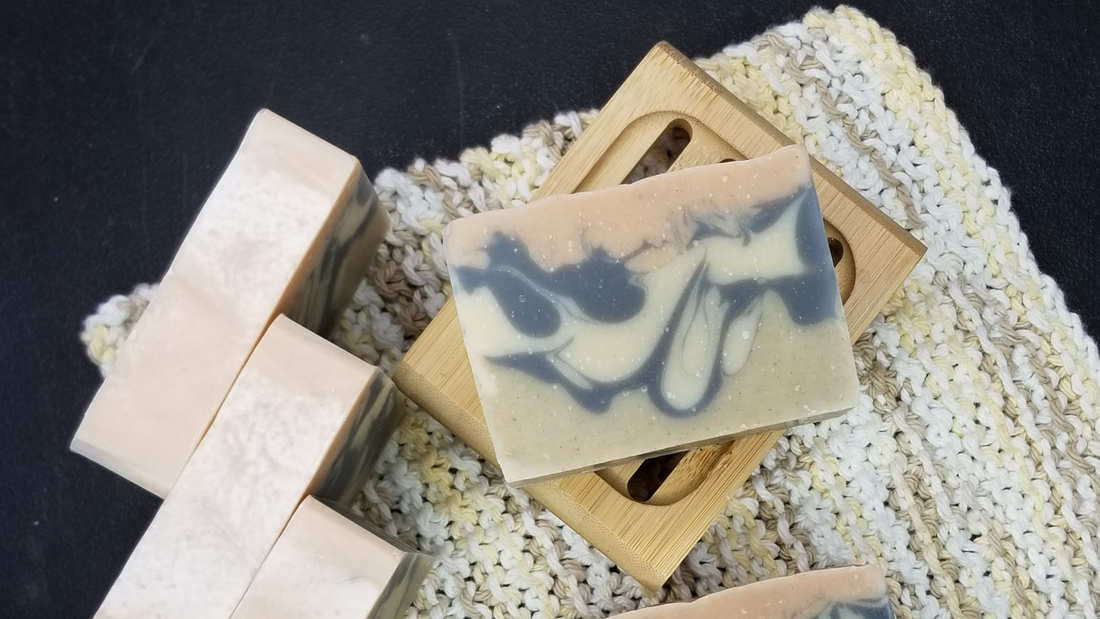If you’ve met me in person or follow our social media accounts, you may have heard me say something like, “If you’re looking for something that is cheap and just foams and cleans, Big Company Soap is the answer. If you’re looking to treat your skin to a variety of natural, skin loving ingredients, give artisan soap a try.”
My short answer when anyone asks “Is goat milk soap good for your skin”, “is it better than ‘not goat milk’ soap”, or even "what makes goat milk soap so trendy" is always the same.
Goat milk is really just another example of a natural, skin loving ingredient used in artisan soap.

So, what makes goat milk soap different from Big Company Soap or even artisan soap made without goat milk?
The goat milk, of course 😉
With that being said, there are a lot of ways to make a goat milk soap - from replacing the entire water amount in a recipe with liquid milk to adding a small amount of powdered goat milk to the soap batter during the blending steps.
Not all goat milk soap is made the same way, and soap makers have access to many different sources of goat milk (from a personal herd of dairy goats to a large-scale manufacturing facility that standardizes liquid milk or turns it into canned or powdered milk). Different processes create goat milks with different qualities.
Artisan soap makers can use goat milk collected and processed in different ways, and every bar is still called ‘soap’ made with goat milk. Not all goat milk soap is created equally.
From raw milk to pasteurized, standardized, and homogenized liquid milk, to powdered milk – it's all soap made with goat milk, and the quality of the goat milk can vary widely!
We'll cover more about the quality differences in goat milk soap in another post. Today we are trying to answer the question – is goat milk soap better for your skin?
To really understand what goes into a bar of goat milk soap, we should talk about chemistry for a second here. If you find that scary, just skip this part.

No matter how the goat milk is collected and processed, I think we can all agree that it contains more protein and fat than water itself. As a cold process soap maker, I can tell you that we create our recipes with a specific ‘superfat’ in mind. But what does that mean?
A soap molecule has two jobs. Half of the soap molecule attaches to fats and oils while the other half attaches to water. This allows soap to clean everything from surfaces in our house to our skin, because it pulls all that dirt and oil right down the drain.
The superfat % allows a cold process soap maker to use enough lye to make soap, but also leaves a bit of extra oil in the soap bar. The higher the superfat, the more extra oil is left after the saponification process (where lye turns oil to soap). It becomes a bit of a dance in our formulations because the higher your superfat, the softer a soap bar will be (and harder bars last longer).
A soap molecule doesn’t care if the oil it grabs was extra soap oil, or the oil present on your skin. Soaps with high superfat values are usually softer bars that are also gentler on your skin. A low superfat means there is less extra oil in the bar, and the soap molecules will pull more oil from your skin.
For example, homemade laundry detergent often has a superfat of 0% because you want the most oil removed from your clothes. This would be super cleansing for your skin as well and leave very little natural oil behind. Homemade cold process soap can have a superfat around 4 to 5% or higher, leaving plenty of extra oil behind so your skin is not stripped of all it’s natural oil.

For those of you who get hives when someone says ‘chemistry’…
Soap made with extra fats and oils is gentler on skin. Goat milk contains extra fats and oils.
When we substitute milk for our water or even add powdered milk to a recipe during blending, we are adding additional fats and proteins to the recipe. This means we end up with a soap bar that has more oil than the exact same recipe made without the milk.
We get a bar that not only has more oil, but also has more protein and sugar – which make for smaller soap bubbles which, in turn, makes a thicker, more indulgent lather.
Now we know the basic difference between goat milk and not goat milk soap:
Goat milk soap has more protein, fat, and sugar compared to the same recipe without milk.
But is it better for your skin?
Let’s take just a second to look at skin itself. I’m sure you already know that there are different types of skin, from oily to normal to dry and everything in between. And you may have oily skin in the summer and dry skin in the winter.

It makes sense that oily skin might need products to be slightly more cleansing. And dry skin or easily irritated skin might need products that are a bit less cleansing or gentler on skin.
This is where goat milk soap can shine!
The extra fat in goat milk soap makes it a gentle cleanser compared to the same recipe without goat milk.
However, if you need that extra cleansing power, you might want to avoid soap made with goat milk, or at least pick a bar made with less goat milk (look for an ingredient label that lists ‘water’ and ‘goat milk’ or ask the maker to help you choose the right product).
Keep in mind that it isn’t just about the goat milk in the recipe. If you’re looking for a great lather without the fat, a soap made with beer, or another sugary ingredient will fit the bill. The number of functional ingredients that can be added to a bar of soap is almost unlimited, so my best advice is – try it out. And try goat milk soap made by several different businesses because it isn’t made the same way by everyone.
An artisan maker, or someone on the internet can tell you that goat milk soap is the only good soap, but at the end of the day, only your skin can tell you if it’s right for you.
I can’t use goat milk soap in the summer. My skin needs the extra cleansing of a ‘not goat milk’ bar. In the wintertime, goat milk soap with added oatmeal is my ‘go to’ bar. For me, goat milk soap is better and worse depending on the time of year.

